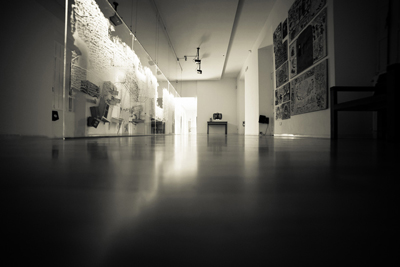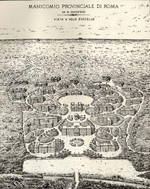You are in: Home page > Magazine Archive > Reenacting memories

Vera Fusco / Francesca Gollo / Marco Salustri
Reenacting memories
Abstract
From the Psychiatric Hospital “Santa Maria della Pietà” to the “Museo Laboratorio della Mente”: memories kept and celebrated in a web of images and stories in a constantly changing community.
Text
«This museum is an aristocratic institution, born from princes’s curiosity and from the treasures of cathedrals and monasteries. Its opening to the world responds to an ideology of cultural democratization that gives to everyone the goods and values belonging to an upperclass culture (a given introduced in terms of "accessibility"), offering to people patterns and norms»
H. De Varine, 2002, pp. 147-148.
«Here, perhaps to clearly underline the big change we are participating in, it could be summarized by saying that it is going from "collection"’s museums to "narration"’s museums. An opened storytelling, tricky and discontinuous, as imposed by the languages and the immaterial culture of our time»
Studio Azzurro, 2011, p. 6.
Making visible the invisible was a categorical imperative for Franco Basaglia who ,in the Brazilian Conferences, writes: "Day after day, year after year, step by step, desperately we found the way to bring outside who was inside and inside who was out" . And it is around this principle of struggle for the exclusion that has developed the recent history of “Santa Maria della Pietà” with the closing of the asylum of Rome and then the birth of the “Museo Laboratorio della Mente” museum. Today this Museum has become the most obvious symbol of the radical transformation of “Santa Maria della Pietà” hosting the ASL Roma 1. From 2015 to reinforce the commitment to safeguard and enhance its cultural heritage, the company has set up the “UOSD Polo Museale Santo Spirito” and the “Museo Laboratorio della Mente”, which unites the monumental complex of the Holy Spirit in Saxia at the Museum, the Historical Archives and the Alberto Cencelli Scientific Library, which are related to the heritage of the former asylum.
The establishment of the “Museo Laboratorio della Mente” has the dual aim of documenting the history of the medical institution and of starting a reflection on the theme of diversity and social exclusion, exemplified by those who suffer or those who suffered in the past from a condition of mental discomfort. The Museum is presented as a narration museum2, today's form is an expression of the videomarkers group named “Studio Azzurro” who have taken care of the set-up by elaborating a path that is made up of tangible and intangible goods. Thanks to the careful use of technology, which sets the museum path, it is possible for the visitor to conduct a complex and engaging experience around these themes. Museum collections are rather heterogeneous and they relate about the history and transformations of “Santa Maria della Pietà”, in addition to the testimonies of the asylum recent past, such as medical equipments and scientific researches, we find more recent artistic productions and artworks such as those by Studio Azzurro. The museum path consists of stages that are articulate around a wall that crosses the entire layout and divides the environments by marking a symbolic limit between the outside and the inside of the asylum as between the social inclusion and exclusion. In this proceeding from the outside to the inside and then from the inside to the outside, step by step, one [1]has the chance to meditate on the concept of normality/diversity, to explore the psychiatric institution through the positions that the progressive depersonalization induced in the patient's body and then confront some paradigmatic stories of the imprisonment. Then finally, memories of places and objects are recalled through a narration that combines the material evidences of the institution through virtual elements such as interviews with witnesses of the “Santa Maria della Pietà”’s story.
Upon the approval of the law 180 of 1978, which was resumed and incorporated in the same year in the law 833 witch establishing the National Sanitary System and the Local Health Units, there were 1076 inmates in “Santa Maria della Pietà” hospital. Since the 1990s, the process of asylums overcoming rapidly evolved, reaching in 1999 its definitive closure with the output of the last 200 patients who will be placed in external residential facilities. These years were marked by deep changes and the whole complex was also affected by a passage of the shareholder from the Province of Rome to the Region of Lazio and to the USL RM / 12 (which will later become ASL Roma E, currently ASL Roma 1). While still working to complete asylum’s closure, in 1991, USL RM / 12 takes a fundamental step by establishing the simple operating unit of the “Center for Studies and Research”; The intent was to protect and enhance the historical and scientific heritage of the former psychiatric hospital. At first, with the financial and technical support of the Ministry for Cultural Heritage and Activities and the Lazio Region Cultural Center, a protection activity is undertaken addressed to the goods wich are more easily recognizable as historical testimonies, the architectural structures, libraries and archives are therefore privileged. Soon, however, we realized that the complex of assets to be safeguarded is much wider, and secondly, that in order to communicate the history and experience of the asylum, an interpretation and a different organization of the same heritage would be necessary . In 1994, the USL destined the pavillion VI to creating a museum space on the history of psychiatric care. In those months the pavillion became a sort of storage where to keep objects and materials recovered within the asylum. It’s important to emphasize the importance of this conservative action, as usual at the closing of the pavilions followed the abandonment of structures and the smoldering of furnishings and important goods. In order to understand how serious and systematic was the dispersion of this heritage, we need to underline two important factors: Law 180 provided for the impossibility of reusing the former spaces of hospitality to accommodate new psychiatric structures, for this reason in these years there wasn’t any architectural recovery project; an even more important element was the radical conviction, especially in the psychiatric culture, to definitively cut off the asylum’s experience with the closing, that implied an irreversible lost of memory. Thanks to the Province of Rome in 1995, it was possible to carry out a first set up of the collected materials, and it was possible to open the “Linea d’Ombra” exhibition: psychiatric care in Rome from the sixteenth to the twentieth century. To carry on this initiative were the same healthcare professionals engaged in clinical work with patients who practiced with museographic works to rebuild and tell a still alive and painful memory of the recent past. At that moment the primary need was to abbreviate the distances between the asylum and the city by telling a story of suffering that was unknown to people, and that was likely to be definitively forgotten. The work was really simple and essential and tended to reshape the space and the asylum treatment by focusing on few furniture and objects that would had to describe the past life of the entire structure. In 2000, with the help of the Ministry of University and Scientific and Technological Research, a museum structure was inaugurated, giving a definitive collocation to the previous exhibition by increasing the exhibition’s space. The current “Museo Laboratorio della Mente” was founded in 2008 by the collaboration between the Center for Studies and Research and Studio Azzurro with the contribution of the Lazio Region. The idea that animates the new exhibition project is crealy knowable in this text made by Studio Azzurro, Narrative’s Museums:
«Many museums born from a clear institutional design, others arise thanks to the perseverance and passion of a single character who, having a deep respect for the cultural heritage’s memory, not only finds the economic resources for the initiative to come, but also creates human conditions for life and development: will, passion, complicity are essential factors that need to be mobilized in a complex adventure like this. The design and realization experience of the “Museo Laboratorio della Mente” of ASL Roma E, located in the former psychiatric hospital “Santa Maria della Pietà” in Rome, is certainly born of all these virtuous components which, in addition, accompany the particular adhesion that the theme of the mental disease demands. But it also arises from the need, in these times of oblivion, to keep in mind the unjust ways in which this suffer has been institutionally dealt with and from the need to recall the unpublished and revolutionary solutions interpreted by the unique experience of Franco Basaglia.» (Studio Azzurro, 2011, p. 131).
The collaboration with Studio Azzurro continues in 2012 with the birth of “Carriers of stories, Nearly nobody is normal”, last step of the exhibition path. The visitor has the opportunity to confront the testimonies of those who are now related to a state of mental discomfort, he can hear the stories only if he chooses to interact with those people who otherwise, silently, continue to walk in front of him. Faces and stories are those of the psychiatric services, users and their relatives; Some of those faces may be found just outside, in “Santa Maria della Pietà”’s park. Today, the “Museo Laboratorio della Mente”, is inserted in the Museum Organization of the Lazio Region and continues to be a kind of training and transformation where memories are preserved to gain a completely new value by creating a shared culture of well-being. This important work is testified by various awards, including the ICOM Italia 2010 Award, the "Quality Mark" of the Lazio Region, the special mention received by ANMLI in 2014, but also by the constant partecipation of visitors, the collaboration with schools and colleges, with health services and with national and international museums.
Biography
Vera Fusco
Anthropologist and Archivist, Formation service “Museo Laboratorio della Mente”, Asl Roma 1
Francesca Gollo
Comunication designer, Formation service “Museo Laboratorio della Mente”, Asl Roma 1
Marco Salustri
Anthropologist and superintendent, Formation service “Museo Laboratorio della Mente”, Asl Roma
2 These museographic experiences are distinguished by an important technological plant, thanks to the active and participatory role assigned to the visitor, to the attention given to the collection and communication of the intangible heritage.
Queste esperienze museografiche si contraddistinguono per un importante impianto tecnologico, per il ruolo attivo e partecipativo assegnato al visitatore, per l’attenzione nella raccolta e comunicazione del patrimonio immateriale. Cfr. Studio Azzurro, Musei di Narrazione, Silvana Editoriale, Milano, 2011.















